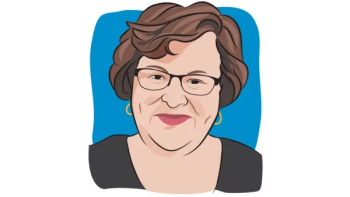Patients with relapsed or refractory (R/R) myelofibrosis experienced reduced biomarkers of disease severity following treatment with the novel p53 potentiating anticancer agent best-in-class MDM2 inhibitor navtemadlin (KRT-232), which suggested that the agent may target disease-driving cells and alter its progression, according to data from the phase 3 BOREAS trial that were presented at the 2024 ASH Annual Meeting.
“I want to emphasize the biology that drives this approach. The MDM2 is a negative regulator of wild-type p53, which is a master determinant of self-fate, and this becomes very critical when you consider its influence over the four hallmarks of myelofibrosis: CD34-positive MF cell proliferation, MF driver gene variant allele frequency (VAF), bone marrow fibrosis, and pro-inflammatory cytokines,” said Dr. John O. Mascarenhas during a presentation of the data.
Mascarenhas is professor of medicine, hematology and medical oncology, director, Center of Excellence for Blood Cancers and Myeloid Disorders and director, Adult Leukemia Program at Mount Sinai Tisch Cancer Center in New York.
In the randomized, multicenter, global phase 3 BOREAS trial, navtemadlin monotherapy was compared with best available therapy (BAT) that included hydroxyurea, peginterferon, immunomodulatory imide drugs or supportive care. Those patients included in the trial had TP53 wild-type myelofibrosis and were R/R to a JAK inhibitor. The data cut-off was Sept. 30, 2024.
Glossary:
CD34-positive MF cell proliferation: the increase of cells that express the protein CD34 in a patient with myelofibrosis.
MF driver gene variant allele frequency (VAF): frequency of genetic mutations that are drivers for myelofibrosis.
Bone marrow fibrosis: when bone marrow is replaced with scar tissue.
Pro-inflammatory cytokines: proteins that start or increase inflammation in the body.
In the study, 183 patients were randomly assigned to receive navtemadlin (123 patients) at 240 milligrams for seven days in a row for a 28-day cycle (with 21 days of drug holiday) or one cycle of BAT (60 patients) for 28 days.
“The patients who were on a JAK inhibitor at the time had a 28-day washout period so that from a spleen and symptom perspective they were clear on day 1 of navtemadlin dosing,” Mascarenhas explained.
“What we saw in terms of biomarkers was a very significant, potent, rapid reduction in circulating CD34 cells as a hallmark of MF even within 12 weeks and sustained over 24 and 36 weeks,” Mascarenhas stated. At 12 weeks, CD34+ cells showed a median reduction of 68% from baseline in 50 patients in the treatment arm and 52% in 25 patients in the BAT arm. This trend continued at 24 weeks (48 patients, 70% reduction versus 19 patients, 38% reduction) and at 36 weeks (21 patients, 76% reduction versus nine patients, 33% reduction).
The reduction in driver gene VAF by 50% or greater was observed in 21% (17of 82) of patients in the treatment arm and 12% (four of 33) of patients in the BAT arm at 24 weeks. “So nearly doubling the molecular response at 24 weeks,” Mascarenhas noted.
Mascarenhas also explained that a reduction in driver VAF was observed to be associated with other biological hallmarks or features of the disease, serving as a surrogate biomarker of disease burden. He continued to explain that the decreases in circulating CD34+ cells and driver gene VAF are associated with an increase in spleen volume response (SVR) with navtemadlin treatment.
In addition, improved bone marrow fibrosis was observed with navtemadlin treatment versus BAT at 24 weeks. In the treatment arm, 2% of patients had improved by two grades or greater, 45% had improved by one grade, 30% were stable and 23% worsened. In the BAT arm, 3% had improved by two grades or greater, 21% had improved by one grade, 52% were stable and 24% worsened.
Pro-inflammatory markers were also assayed, and treatment with navtemadlin showed a reduction in serum cytokine levels over a 48-week period, Mascarenhas noted.
Regarding baseline demographics, in the treatment arm 59% had primary MF subtype and 42% had secondary. In the BAT arm 58% had primary MF subtype and 42% had secondary. Regarding driver mutations, JAK2 mutations were observed in 72% of the treatment arm and 65% of the BAT arm; CALR mutations in 18% versus 27%; MPL mutations in 4% versus 2% and triple-negative cases in 6% versus 7%, respectively.
High molecular risk mutations (at least one) were observed in 62% of the treatment arm and 68% of the BAT arm, and high molecular risk mutations (at least two) were seen in 24% and 23%, respectively. ASXL1 mutations were present in 56% versus 60%, and EZH2 mutations in 15% versus 7%, each respectively. Bone marrow fibrosis scores for grades 1, 2 and 3 were 9% versus 10%, 35% versus 35% and 46% versus 37%, respectively. “So, a very advanced patient population who had failed JAK inhibitor therapy upfront,” Mascarenhas summarized.
“The primary end point was SVR35 at 24 weeks,” Mascarenhas said. SVR35 is defined as an SVR of 35% or more from baseline after 24 weeks. Exploratory end points included reduction in the following: CD34+ cell count in peripheral blood, VAF, cytokines and bone marrow fibrosis. Combinations of these were assessed at pre-dose, weeks 12, 24 and then every 12 weeks.
The randomized, double-blinded add-on phase 3 POIESIS study will explore navtemadlin in combination with Jakafi (ruxolitinib) in patients with JAK inhibitor-naive myelofibrosis. Patients will start by taking Jakafi alone during the initial phase, and those who show a suboptimal response are randomly assigned to receive either navtemadlin (120 patients) or placebo (60 patients) in addition to ongoing Jakafi treatment.
The coprimary end points of this study are targeted SVR and total syndrome score reduction at 24 weeks after randomization.
“The BOREAS trial is the first global phase 3 trial, conducted solely in patients with MF who are truly R/R to JAK inhibitor treatment, to report results. Navtemadlin monotherapy has been shown to improve biomarkers of disease burden in this patient population that I would argue is suggestive of anti-clonal activity and disease modification. This includes reduction in CD34 cell, driver mutation burden, serum inflammatory cytokine levels and importantly correlating with SVR, which is a key clinical outcome predictive of quality of life and overall survival,” Mascarenhas said.
Reference:
“Disease-modifying activity of navtemadlin correlates with clinical responses in a randomized, multicenter, global phase 3 study (BOREAS) in JAK-inhibitor relapsed/refractory myelofibrosis” by Dr. John O. Mascarenhas et al., Blood.
For more news on cancer updates, research and education, don’t forget to subscribe to CURE®’s newsletters here.





